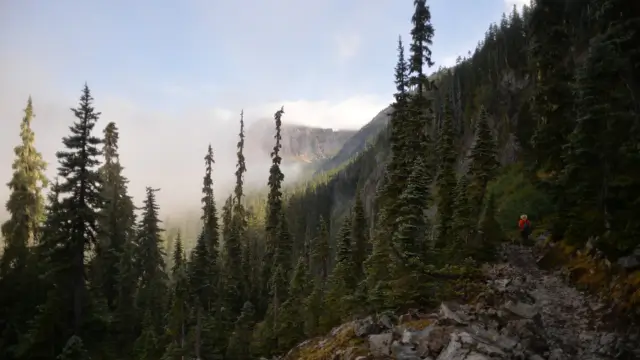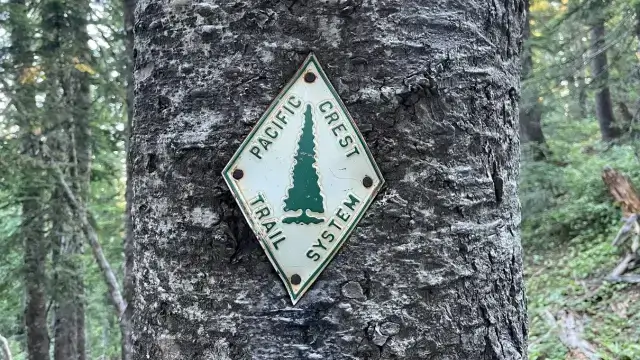Hiking the Pacific Crest Trail: Beginner’s Guide
The Pacific Crest Trail (PCT) is a long-distance hiking and equestrian trail that runs from the Mexican- U.S border all the way to the Canadian-United States border.
Stretching over 2,600 miles, the PCT traverses through California, Oregon, and Washington and offers hikers breathtaking views of the Pacific Ocean, the Cascade and Sierra Nevada mountain ranges, and a variety of ecosystems along the way.
The trail presents a unique challenge to those who choose to hike it, as it requires careful planning, physical endurance, and mental resilience.
Both seasoned hikers and newcomers are drawn to the PCT for a multitude of reasons including the opportunity to disconnect from the hustle and bustle of daily life, to test their physical and mental limits, and to gain a deeper appreciation for nature.
Hiking the Pacific Crest Trail provides a sense of accomplishment and clarity that comes from simply placing one foot in front of the other for several months at a time.
Anyone with the physical and mental preparedness, as well as the necessary permits, can hike the PCT, regardless of age, gender, or nationality.
The PCT is an opportunity for hikers to immerse themselves in a life-changing adventure and create lasting memories in the great outdoors.
Planning for Hiking the Pacific Crest Trail

When planning your hike on the Pacific Crest Trail, there are several factors to consider.
1. Thru-hiking vs. section hiking
One of the first decisions to make is whether you will be thru-hiking the entire trail or section hiking it.
Thru-hiking involves completing the entire 2,650-mile trail in one go, while section hiking entails completing the trail in smaller segments over time. Check out these Guidebooks and let your mind wander to the mountains of the West.
Read also: How Long Does It Take To Hike The Pacific Crest Trail?
2. Choosing a direction: Northbound vs. Southbound
Another decision to make is whether to hike northbound (NOBO) from Mexico to Canada or southbound (SOBO) from Canada to Mexico.
Each direction offers its own set of challenges and rewards, so it’s important to carefully consider which option suits your hiking style and abilities.
3. Permits and regulations
Obtaining the necessary permits and being aware of the regulations for hiking the PCT is crucial in order to stay in compliance with trail management authorities.
4. Resupply options
Resupply options along the trail are also important to consider, as you will need to plan where to restock on food and other supplies. Check this list of PCT resupply locations and towns.
5. Training and conditioning
Adequate training and conditioning are also essential in preparing for the physical and mental demands of the trail.
Whether it’s building endurance, strength, or learning important survival skills, it’s important to adequately prepare your body and mind for the rigors of the trail.
Pro tip: when hiking PCT, don’t go alone; always find an expert hiker who will take you out. Find a partner on meetup.com and the PCT Facebook group.
6. Gear and equipment
Having the appropriate gear and equipment for the varying terrain and weather conditions is vital for a successful hike on the PCT.
Let’s delve into the key gear essentials that will ensure you’re well-prepared for the challenges that the PCT presents.
Getting lost on the PCT, while relatively rare, can be a serious concern. Equip yourself with the necessary tools for navigation: topographic maps, compass, altimeters, GPS units, trip reports from fellow hikers, and smartphones can serve as valuable bonuses. Check out PCT interactive map.
Days on the PCT, especially at high elevations, expose you to intense sunlight. Protect yourself from potential harm with: sunglasses, sunscreen and lip balm, a broad-brimmed hat, neck coverage, long-sleeved shirts, long pants, and sun gloves.
Prepare for extremes in weather conditions by packing ample warm clothing, even on a sunny day, carry warm clothing for unexpected foul weather or emergencies. Think puffy coat, gloves, and a beanie to guard against hypothermia.
Ensure you have a reliable light source, even if you plan to return before dark. Headlamp or Flashlight are essential for emergencies or situations where you may need to navigate in low light conditions. And don’t forget to carry spare batteries.
Carry and know how to use a well-stocked first aid kit. While a first aid kit is crucial, always prioritize steps to avoid injury or sickness in the first place.
Be prepared to start and sustain an emergency fire by carrying two reliable lighters or matches in a waterproof container. Fire starters are indispensable for igniting wet wood.
When venturing along the Pacific Crest Trail (PCT), consider the following essential tools to ensure you’re well-prepared for a variety of situations: knife, safety pins, needle and thread (Dental Floss), duct tape, nylon Fabric Repair Tape, cordage. Also, extra laces and repair kit for addressing issues with your footwear, and spare strap or a set of quick-release buckles for backpack strap repair.
For shorter trips, always carry a one-day emergency supply of easily digestible, non-cooking food. During shoulder seasons or longer excursions, consider adjusting the quantity accordingly.
Carry extra water and the tools for obtaining and purifying additional water.
Read more: Backpacking Meal Planning & Food Ideas
Have a plan for shelter, especially if not carrying a traditional tent. Carry a jumbo plastic trash bag or a reflective emergency blanket for protection against rain and wind.
With careful planning and preparation, you’ll be well-equipped to embark on your PCT adventure.
The Hiking Experience on PCT

The hiking experience on the Pacific Crest Trail (PCT) is a journey through diverse landscapes, including deserts, mountains, and forests.
These varying terrains offer hikers a unique opportunity to encounter a wide range of natural beauty and terrain.
Along the way, hikers often come across a variety of wildlife, from deer and chipmunks to bears, rattlesnakes, salamanders, eagles, coyotes, marmots, roadrunners, elk, mountain goats, bobcats, and cougars.
These encounters add an element of excitement and adventure to the trek. Read more about wildlife of the Pacific Crest Trail.
However, it’s not just the scenery and wildlife that make the PCT experience so special. The PCT community, made up of both trail angels and fellow hikers, also plays a significant role in the journey.
- Trail angels are volunteers who offer assistance and support to hikers along the trail, providing supplies, transportation, and encouraging words.
- Fellow hikers also provide camaraderie and companionship, forming a tight-knit community of individuals all pursuing the same goal.
Read also: 10 Pacific Crest Trail Movies
Challenges and Rewards of Long-Distance Hiking
Long-distance hiking on the PCT presents a series of challenges, from physical endurance and mental fortitude to navigating potential hazards and unpredictable weather.[1]
1. Physical Challenges:
- Aches and pains, especially in the first few days.
- Blisters and calluses.
- Daily soreness and muscle fatigue.
- Lingering pain in feet, shoulders, back, and hips.
2. Mental and Emotional Challenges:
- Coping with physical discomfort on a daily basis.
- Dealing with the isolation of not seeing other hikers for extended periods.
- Adapting to the ever-changing environment and weather.
- Navigating potential risks and dangers, both real and perceived.
But, the rewards of completing such a journey are immeasurable. The sense of accomplishment, the connection to nature, and the bonds formed with others along the way all contribute to a truly transformative experience.
The PCT offers hikers the chance to push themselves beyond their limits, connect with the natural world, and join a supportive and inspiring community of like-minded individuals.
Read more about: Hiking The Pacific Crest Trail In Winter
Thru-hiker Pacific Crest Trail FAQ
What’s the best time to start the Pacific Crest Trail?
The best time to start the PCT is generally in late April or early May to ensure you avoid harsh winter weather in the Sierra Nevada and Cascades.
How long does a PCT thru-hike take?
A typical PCT thru-hike takes about 5-6 months to complete, covering over 2,650 miles from the Mexican border to the Canadian border.
What permits do I need for the PCT?
In terms of permits, hikers need to obtain a PCT Long-distance Permit, which allows them to stay overnight in certain areas along the trail.
How warm a sleeping bag do I need?
For sleeping bags, a 20-30 degree Fahrenheit bag is recommended to handle the varying temperatures encountered along the trail.
Is hiking the Pacific Crest Trail hard?
The PCT is undoubtedly a challenging hike, both physically and mentally, but the rewards of experiencing the diverse and stunning landscapes of the western United States are well worth it.
How much does it cost to hike the pct?
As for cost, most thru-hikers spend around $4,000-$8,000 on gear, permits, food, and other expenses during their journey.
Tips and Advice to hike the PCT
If you’re planning to hike the Pacific Crest Trail (PCT), there are a few important tips and pieces of advice to keep in mind.
First and foremost, it’s crucial to start early and plan well. The PCT covers a vast and varied terrain, so thorough planning and preparation are essential for a successful hike.
It’s also important to be prepared for all weather conditions. The trail passes through deserts, forests, and high mountain peaks, so hikers should be ready for both extreme heat and cold temperatures.
Additionally, packing light and efficiently is key to an enjoyable and manageable hike. Every ounce counts when you’re carrying your gear on your back for hundreds of miles, so be sure to pack only the essentials and invest in lightweight, high-quality gear.
Leave no trace is another crucial rule for hiking the PCT. With the increasing popularity of the trail, it’s more important than ever to minimize your impact on the environment and leave the trail as pristine as you found it.
Finally, it’s important to remember that the journey is just as important as the destination! While conquering the Pacific Crest Trail offers stunning scenery, diverse landscapes, and an unmatched connection with nature, safety should always be paramount.
Before embarking on your adventure, inform a trusted person about your itinerary and share updates regularly. If you ever stray off the trail or become lost, remember to “hug a tree”: stay put, conserve energy, and use the survival gear that you have. Check out these additional safety tips.
So start early, plan well, pack light, leave no trace, and most importantly, enjoy the adventure of hiking the PCT!
Source: Pacific Crest Trail Association (PCTA), Mental and Emotional Challenges of a PCT Thru-Hiker from The Trek website.